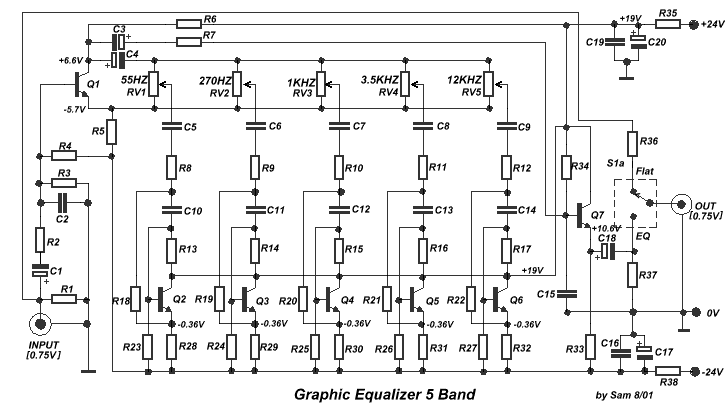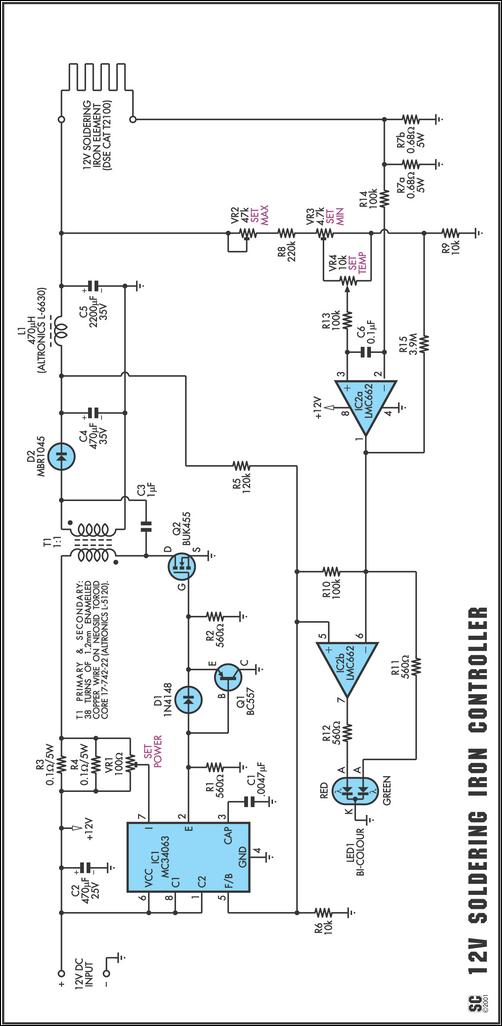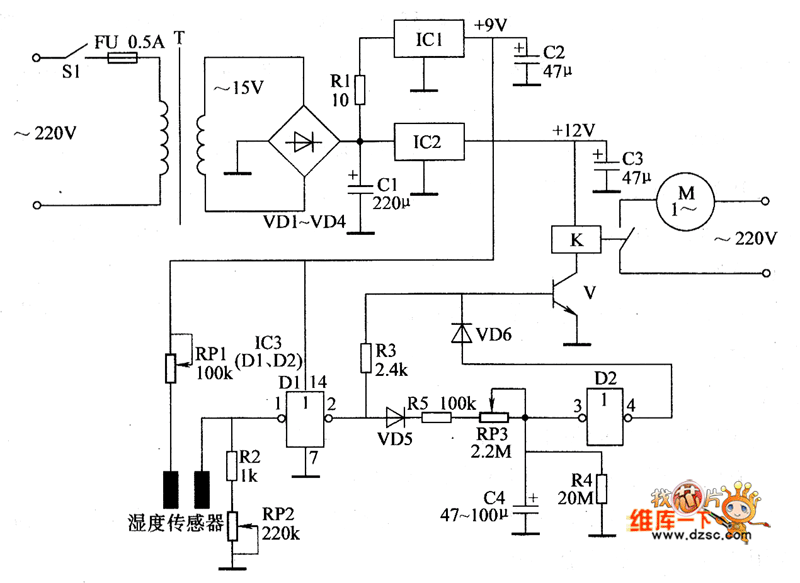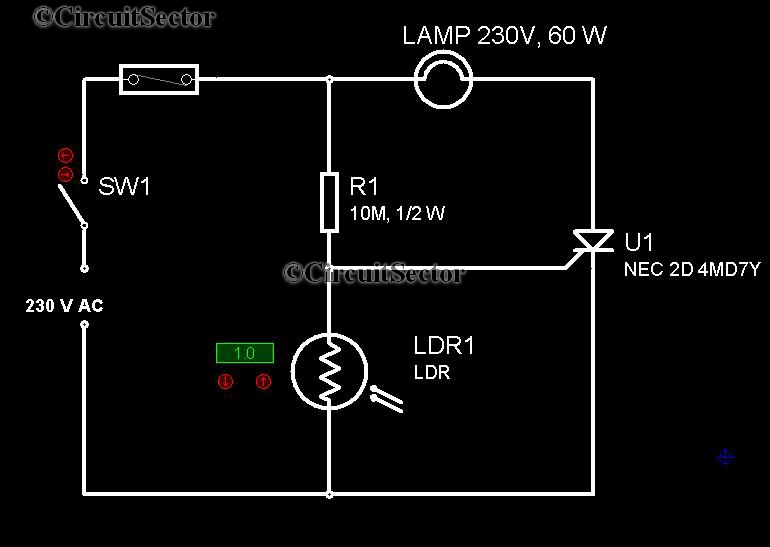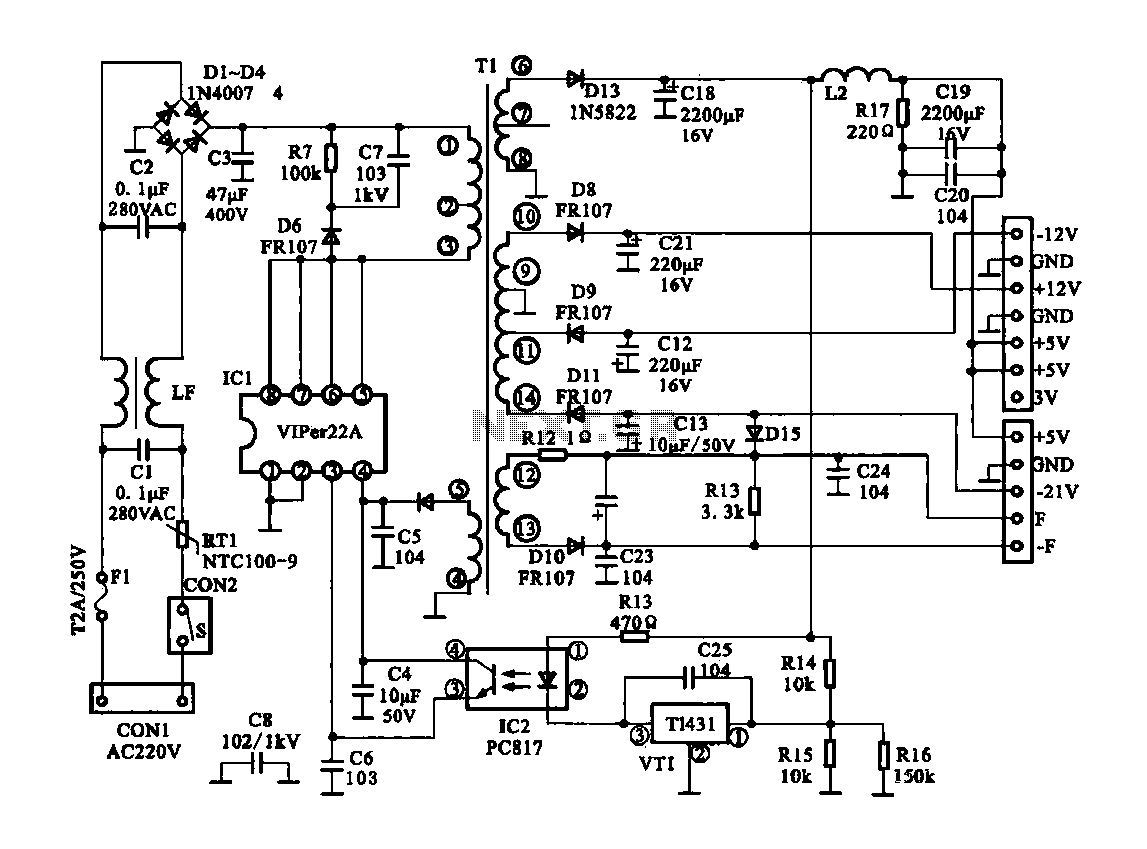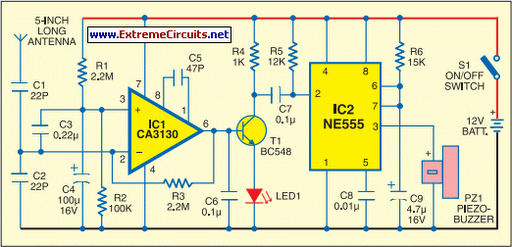
Metal detector circuit with TDA2822
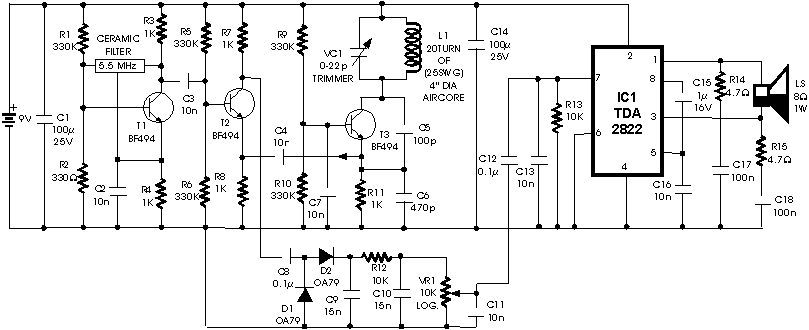
The metal detector circuit is shown here that the limits represent the sake of simplicity for a metal detector, but the design works remarkably well. It only uses 40,106 Hex Schmitt inverter IC, a capacitor and a search coil and of course batteries. An advantage of IC1b Pin 4 is to be connected to a medium-wave radio antenna, or it should be wrapped around the radio. It can also be used as a hand-held metal detector. As you can see what metal a good selection of beat-frequency operation (BFO), up to 90 mm for a bottle-top. In fact, for the ultimate in simplicity, the capacitor C1 is omitted. In this way, the author reaches is astonishing, 150mm range for the bottle top. But with the frequency then to more than 4 MHz, the instability is a major problem. As shown in the circuit, oscillates at 230kHz. You can also experiment with the frequency by changing the value of C1. Faraday shield can be added to reduce ground-effect and capacitive coupling, and this is connected to 0V. Since the inductance is resistance to rapid change in voltage, the charging of fees C1 delayed a bit like the logical level IC1a 2-pole change. This requires a rapid oscillations, which is repealed by an AM radio. Any change in the inductance in the search coil (by the presence of metal) to a change in the oscillator frequency. Although 230kHz is out of reach for the medium-wave band, an AM radio will significantly increase this frequency harmonics.
Metal detector calibration This makes the search coil L1 is much room for error and is not far from conclusive. The author uses seventy turns 30 s.w.g. (0,315 mm) copper wire on a former 120mm diameter. The metal detector, set up by the AM radio to pick up a whistle. Not all of these harmonic functions well, and are best suited to. The presence of metal will significantly change the sound of the whistle.
The metal detector circuit employs a 40,106 Hex Schmitt inverter IC as the primary component, which facilitates the generation of oscillations used for detecting metallic objects. The circuit's simplicity is achieved through the integration of a search coil, a capacitor, and a power source, typically batteries. The design allows for the connection of IC1b Pin 4 to a medium-wave radio antenna, enhancing its functionality by enabling the detection of frequency harmonics through the radio.
The operation of this metal detector is based on a beat-frequency oscillator (BFO) principle, which allows for the detection of metals at a range of up to 90 mm for small objects like bottle caps. For enhanced simplicity, the capacitor C1 can be omitted, resulting in an impressive detection range of 150 mm. However, operating at frequencies exceeding 4 MHz introduces significant instability into the circuit. The circuit is designed to oscillate at a frequency of approximately 230 kHz, which is optimal for the intended application.
The search coil, denoted as L1, is a critical component that influences the circuit's performance. It is constructed using seventy turns of 30 SWG (0.315 mm) copper wire wound around a 120 mm diameter former. This configuration provides a suitable inductance that is sensitive to changes in voltage, allowing for effective detection of metallic objects. The presence of a metal object alters the inductance of the search coil, which in turn modifies the oscillator's frequency, resulting in a change in the audio output when interfaced with an AM radio.
To minimize issues related to ground effects and capacitive coupling, a Faraday shield may be incorporated into the design, connected to a common ground (0V). This addition enhances the circuit's stability and accuracy. The calibration of the metal detector can be fine-tuned by adjusting the value of capacitor C1, which influences the frequency of oscillation and the sensitivity of detection.
Overall, the circuit demonstrates an effective method for metal detection using a minimal number of components while allowing for adjustments to optimize performance. The audible output generated by the AM radio serves as an indicator of the presence of metallic objects, with variations in sound signaling changes in inductance caused by nearby metals.The metal detector circuit is shown here that the limits represent the sake of simplicity for a metal detector, but the design works remarkably well. It only uses 40,106 Hex Schmitt inverter IC, a capacitor and a search coil and of course batteries. An advantage of IC1b Pin 4 is to be connected to a medium-wave radio antenna, or it should be wrapped around the radio.
It can also be used as a hand-held metal detectors. As you can see what metal a good selection of beat-frequency operation (BFO), up to 90 mm for a bottle-top. In fact, for the ultimate in simplicity, the capacitor C1 is omitted. In this way, the author reaches is astonishing, 150mm range for the bottle top. But with the frequency then to more than 4 MHz, the instability is a major problem. As shown in the circuit, oscillates at 230kHz. You can also experiment with the frequency by changing the value of C1. Faraday shield can be added to reduce ground-effect and capacitive coupling, and this is connected to 0V.
Since the inductance is resistance to rapid change in voltage, the charging of fees C1 delayed a bit like the logical level IC1a 2-pole change. This requires a rapid oscillations, which is repealed by an AM radio. Any change in the inductance in the search coil (by the presence of metal) to a change in the oscillator frequency.
Although 230kHz is out of reach for the medium-wave band, an AM radio will significantly increase this frequency harmonics. Metal detector calibration This makes the search coil L1 is much room for error and is not far from conclusive.
The author uses seventy turns 30 s.w.g. (0,315 mm) copper wire on a former 120mm diameter. The metal detector, set up by the AM radio to pick up a whistle. Not all of these harmonic functions well, and are best suited to. The presence of metal will significantly change the sound of the whistle. 🔗 External reference
Metal detector calibration This makes the search coil L1 is much room for error and is not far from conclusive. The author uses seventy turns 30 s.w.g. (0,315 mm) copper wire on a former 120mm diameter. The metal detector, set up by the AM radio to pick up a whistle. Not all of these harmonic functions well, and are best suited to. The presence of metal will significantly change the sound of the whistle.
The metal detector circuit employs a 40,106 Hex Schmitt inverter IC as the primary component, which facilitates the generation of oscillations used for detecting metallic objects. The circuit's simplicity is achieved through the integration of a search coil, a capacitor, and a power source, typically batteries. The design allows for the connection of IC1b Pin 4 to a medium-wave radio antenna, enhancing its functionality by enabling the detection of frequency harmonics through the radio.
The operation of this metal detector is based on a beat-frequency oscillator (BFO) principle, which allows for the detection of metals at a range of up to 90 mm for small objects like bottle caps. For enhanced simplicity, the capacitor C1 can be omitted, resulting in an impressive detection range of 150 mm. However, operating at frequencies exceeding 4 MHz introduces significant instability into the circuit. The circuit is designed to oscillate at a frequency of approximately 230 kHz, which is optimal for the intended application.
The search coil, denoted as L1, is a critical component that influences the circuit's performance. It is constructed using seventy turns of 30 SWG (0.315 mm) copper wire wound around a 120 mm diameter former. This configuration provides a suitable inductance that is sensitive to changes in voltage, allowing for effective detection of metallic objects. The presence of a metal object alters the inductance of the search coil, which in turn modifies the oscillator's frequency, resulting in a change in the audio output when interfaced with an AM radio.
To minimize issues related to ground effects and capacitive coupling, a Faraday shield may be incorporated into the design, connected to a common ground (0V). This addition enhances the circuit's stability and accuracy. The calibration of the metal detector can be fine-tuned by adjusting the value of capacitor C1, which influences the frequency of oscillation and the sensitivity of detection.
Overall, the circuit demonstrates an effective method for metal detection using a minimal number of components while allowing for adjustments to optimize performance. The audible output generated by the AM radio serves as an indicator of the presence of metallic objects, with variations in sound signaling changes in inductance caused by nearby metals.The metal detector circuit is shown here that the limits represent the sake of simplicity for a metal detector, but the design works remarkably well. It only uses 40,106 Hex Schmitt inverter IC, a capacitor and a search coil and of course batteries. An advantage of IC1b Pin 4 is to be connected to a medium-wave radio antenna, or it should be wrapped around the radio.
It can also be used as a hand-held metal detectors. As you can see what metal a good selection of beat-frequency operation (BFO), up to 90 mm for a bottle-top. In fact, for the ultimate in simplicity, the capacitor C1 is omitted. In this way, the author reaches is astonishing, 150mm range for the bottle top. But with the frequency then to more than 4 MHz, the instability is a major problem. As shown in the circuit, oscillates at 230kHz. You can also experiment with the frequency by changing the value of C1. Faraday shield can be added to reduce ground-effect and capacitive coupling, and this is connected to 0V.
Since the inductance is resistance to rapid change in voltage, the charging of fees C1 delayed a bit like the logical level IC1a 2-pole change. This requires a rapid oscillations, which is repealed by an AM radio. Any change in the inductance in the search coil (by the presence of metal) to a change in the oscillator frequency.
Although 230kHz is out of reach for the medium-wave band, an AM radio will significantly increase this frequency harmonics. Metal detector calibration This makes the search coil L1 is much room for error and is not far from conclusive.
The author uses seventy turns 30 s.w.g. (0,315 mm) copper wire on a former 120mm diameter. The metal detector, set up by the AM radio to pick up a whistle. Not all of these harmonic functions well, and are best suited to. The presence of metal will significantly change the sound of the whistle. 🔗 External reference
Warning: include(partials/cookie-banner.php): Failed to open stream: Permission denied in /var/www/html/nextgr/view-circuit.php on line 713
Warning: include(): Failed opening 'partials/cookie-banner.php' for inclusion (include_path='.:/usr/share/php') in /var/www/html/nextgr/view-circuit.php on line 713
